
Area 51 raiders: from meme to micro-population?
On June 27, 2019, Matty Roberts created a Facebook event called ‘Storm Area 51, They Can’t Stop All of Us’ (Betz, 2019). The goal of the event was to raid Area 51, a US Air Force facility, which is believed to hold extraordinary artefacts, including (evidence of) extraterrestrial life.
The Facebook event grew massively, and eventually an Area 51 raiders group was created. Still, the whole endeavor was in a comical vein (Fortin, 2019), and there was no actual intention of raiding the site. The creator of the event was (at the very least) surprised to see that by the event date, September 20, 2019, over 2 million people had responded with ‘going’ and 1.5 million had responded that they were ‘interested’.
The event made world news because of these enormous numbers and it turned into a worldwide internet meme. There were festivals planned from September 19 to September 21 to draw even more people. For months, the anticipation for the raid grew and grew, only to lead to around 150 people actually showing up at the gate of Area 51 on September 20, and none of them getting in (Baynes, 2019). Seven of these people, dubbed ‘Area 51 raiders’, were arrested that day. What might be even more interesting, is that the people who responded to the Facebook event with ‘going’ and ‘interested’ also identified themselves as Area 51 raiders. Who are these people, how do they behave both on- and offline, and can we call them a social group?
Area 51 raiders: what went down
Matty Roberts created the widely known ‘Storm Area 51’ event on Facebook thinking nothing of it except that it was a funny joke (Betz, 2019). Three days later, the event had gone viral on TikTok, Reddit, and Instagram, which led to a surprising two million Facebook users ‘going’, and another 1.5 million being ‘interested’. People appeared to be very actively involved since the beginning of the Facebook event, hoping for it to become as big as it possibly could.
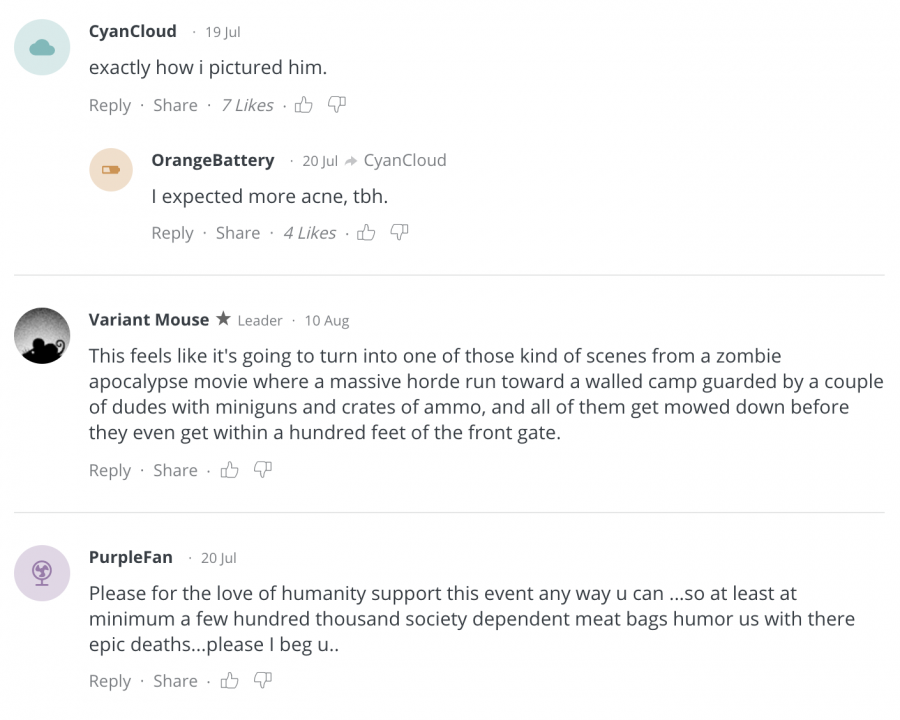
People interested in the Area 51 raid comment under the reveal of the Facebook event creator's face.
People started sharing jokes and satirical posts on various platforms to discuss how everyone could storm Area 51 in the most efficient way. The now so-called Area 51 raiders knew they were part of a meme that was set to become even bigger. They loved the attention. After the event went viral, Roberts started to organize a music festival based on the event called ‘Alienstock’ as he had second thoughts about organizing the actual raid (Prior, 2019). The festival would be safer, and it could also make him some money. Some counties around Area 51 declared an emergency since, for instance, Lincoln county only has 184 hotel rooms and limited cellphone network coverage. They just couldn’t deal with the anticipated forty thousand people (Hoffman, 2021).

The festival created for Area 51 raiders: Alienstock
As the anticipation started to grow bigger, people started to look at the officials of Area 51. Air Force spokeswoman Laura McAndrews spoke with the Washington Post telling them that officials were aware of the event, but couldn’t say how authorities would respond to the raiders who actually would go through with the plan. She also warned possible Area 51 raiders by stating that "the US Air Force always stands ready to protect America and its assets".
There are rumors that the Air Force hired extra security for September 20. On September 12, two Dutch YouTubers, Ties Granzier and Govert Sweep, were arrested; the news shocked the world and made the anticipation even bigger. On the actual day of the event, only around 150 people actually went to the gates of Area 51, from which seven were arrested. A lot of people went to the festival instead: around seven to ten thousand according to estimates. The event was eventually changed to ‘Official Alienstock Tour’ and was planned to take place from September 18 to September 20, 2020.
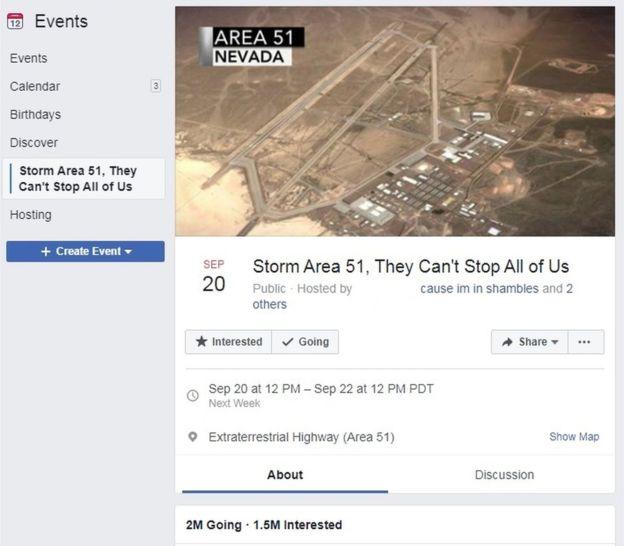
The Facebook event that went viral, which got two million 'going' clicks and 1.5 million 'interested' clicks.
Why Area 51?
This isn’t the first time Area 51 has been made the subject of internet memes. The site has been described in many conspiracy theories as a place where the government of the United States keeps aliens, unidentified flying objects (UFOs), weather control instruments, time travel technology, and more (Fortin, 2019). People claim they have seen UFOs, a secret underground base, or even mystery mushroom clouds coming from Area 51.
'Area 51' isn't actually the site's official name according to the CIA; in fact, the origin of the nickname is unclear.
Officially, the base is a highly classified, heavily surveilled United States Air Force (USAF) facility located in southern Nevada, around 134km north-northwest of Las Vegas. The area surrounding the facility and the adjacent lake, Dry Groom lake, are off-limits to both civilian and ordinary military air traffic. What exactly happens there is not public knowledge, but the USAF says the site is an open training range where experimental aircraft and weapon systems are developed and tested. 'Area 51' isn’t actually the site's official name according to the Central Intelligence Agency (CIA); in fact, the origin of the nickname is unclear, while its official name is Homey Airport or Groom Lake.
The impact of 'They Can't Stop All of Us'
Roberts' Facebook event became a worldwide phenomenon, resulting in scores of memes. First was the ‘Naruto run' meme. To quote the event, "if we Naruto run, we can move faster than their bullets. Let’s see them aliens" (Fortin, 2019). In the title picture of this article, a person can be seen Naruto-running in the background of a news report covering the Area 51 raid. This picture explains the whole situation perfectly, capturing how the whole thing is both serious and un-serious at the same time (Hoffman, 2021). 'Naruto running' refers to the running style of an anime character called Naruto Uzumaki, who runs with his head down, arms stretched backwards, and torso tilted forward. After the official statement by Laura McAndrews, people started joking about officials having to explain what a Naruto run is.

Meme about Naruto running into Area 51.
Other memes that got a lot of attention and laughs by users are the ‘me coming home after storming Area 51 with …' meme, the ‘Area 51 guards after seeing the first wave of Kyles, Chads, Karens, …’ meme and the ‘Got me my alien’ meme. Area 51 raiders or enthusiasts were to be found on almost every social media platform. The most shocking meme was a Twitter post by the Defense Visual Information Distribution Service (see below). The DVIDS is the official organization that provides the connection between the world media and American military personnel serving both abroad and in the US. It's the military's media and public relations department. The tweet was later deleted and the DVIDS posted an apology (BBC News, 2019).

The shocking tweet of the Defense Visual Information Distribution Service
Another meme, which can be seen below, was shared and liked globally due to its references to other social groups. All groups mentioned, such as Anti-vax Kids, Karens, and Crack Heads are widely considered as weird, wild, and most of all, people that are ready to fight. The "rest of us sneaking in safely"-category in the 'attack plan' suggests that the 'normal' people will enter the base unharmed while the other, aggressive groups distract the guards and soldiers. The meme was evidently made by a person who would see themselves as part of the 'rest' since they are evidently mocking the other social groups by sacrificing them in their plan, which is of course, entirely satirical.
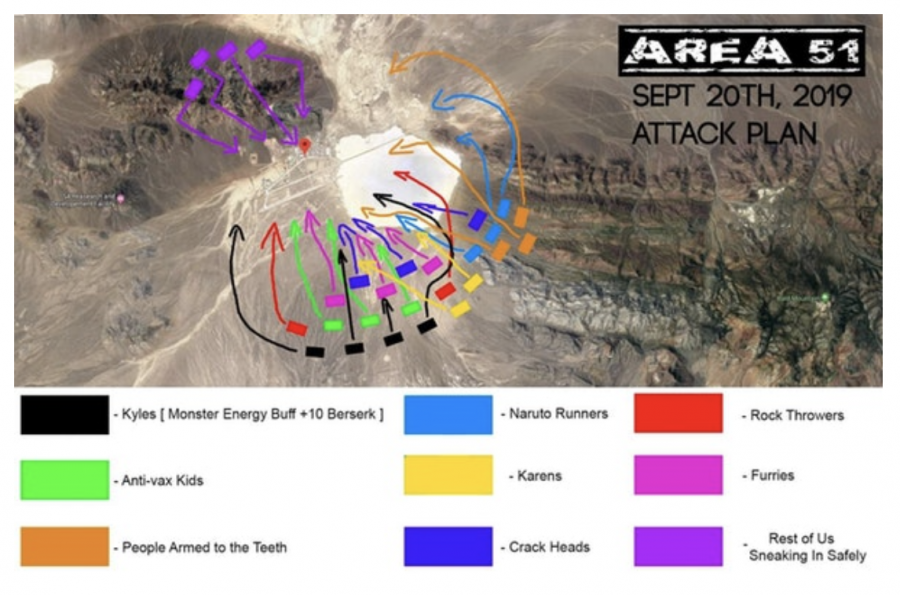
The Area 51 raiders' plan of attack for September 20, 2019.
The 'typical' Area 51 raiders
Area 51 raiders could be described as a social group with a certain language, cultural practices and specific ways of dressing. The Facebook event and the memes can be seen as phatic communication creating bonds between people from different places in the world. There is no truly ‘typical’ Area 51 raider, but 'raiders' do have some characteristics in common. First of all, they are really into memes. All Area 51 raiders know they are a part of one big meme, and they love it. One of their many niche memes is the 'Area 51 starter pack' meme, which lists items that one might expect to be essential when raiding Area 51. Further, it seems that the majority of the raiders also identify as gamers, and are generally young (mostly teenagers and adults in their twenties).
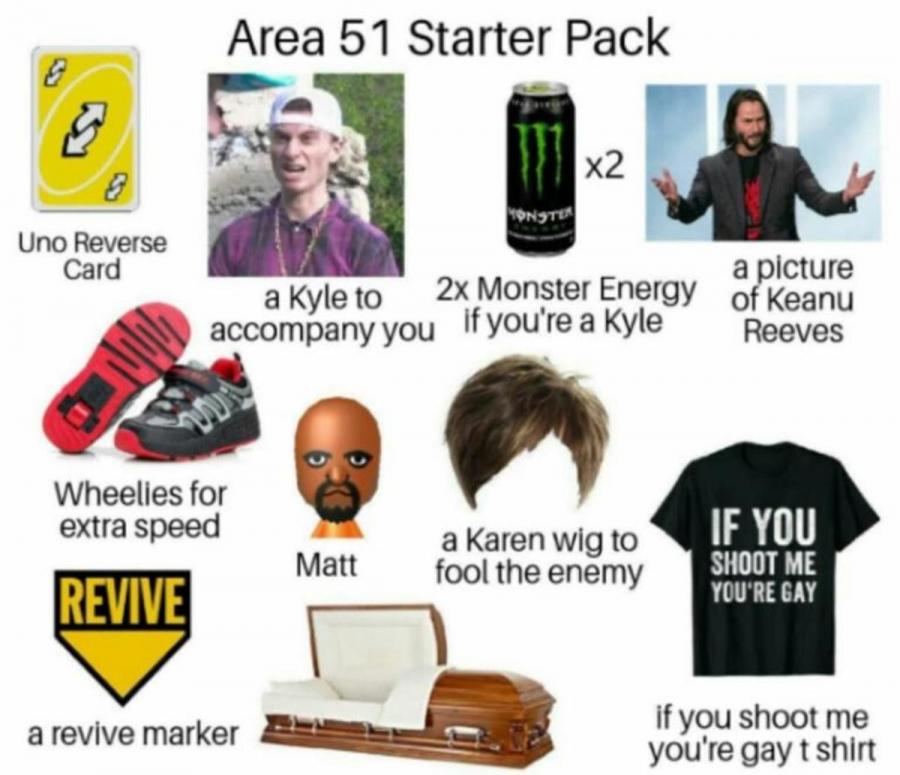
Area 51 starter pack: essentials for a raider.
Area 51 raiders are also very aware of the conspiracy theories surrounding Area 51 and have their own opinions about these theories. Most of them believe, or at least (ironically) claim to believe, that Area 51 is, put simply, where the government keeps the aliens. Some have claimed to have seen UFOs, but for the most part, the raiders aren’t even from the area close to the Air Force facility. Their claims don't necessarily have to be true though. On the internet, Area 51 raiders talk as if all manner of peculiar things have happened or are going to happen, but it's difficult to decide whether everyone is being ironic or serious. Poe's law very much applies in the case of this raid.
As for their appearance, an Area 51 raider is either dressed up or just in regular clothes. Some of the raiders or festival attendees dressed up as aliens or wore clothes with weird prints, but the majority just wore their everyday clothes, for example jeans and a sweater or t-shirt with a humorous print, as seen on group photos on Twitter and on the news. You wouldn't immediately notice every Area 51 raider in a crowd.
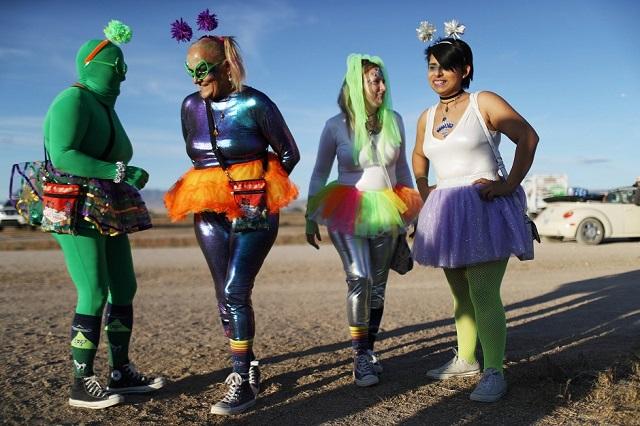
Few of the Area 51 raiders dressed up as aliens.
It's the signs the raiders carry that make them stand out. A lot of people showed up to the raid with signs with slogans like "clap alien cheeks", "locked up for what?", "run faster than their bullets" and "raid that alien booty". These signs were all carried offline, but online a lot was happening as well.
Of course, all the memes discussed here are found on online social media platforms as collective products, but Area 51 raiders also do more individual things; they tweet about the event constantly, respond to news articles, and count down the days until the big raid. They watch gamers on YouTube and post memes on Reddit.
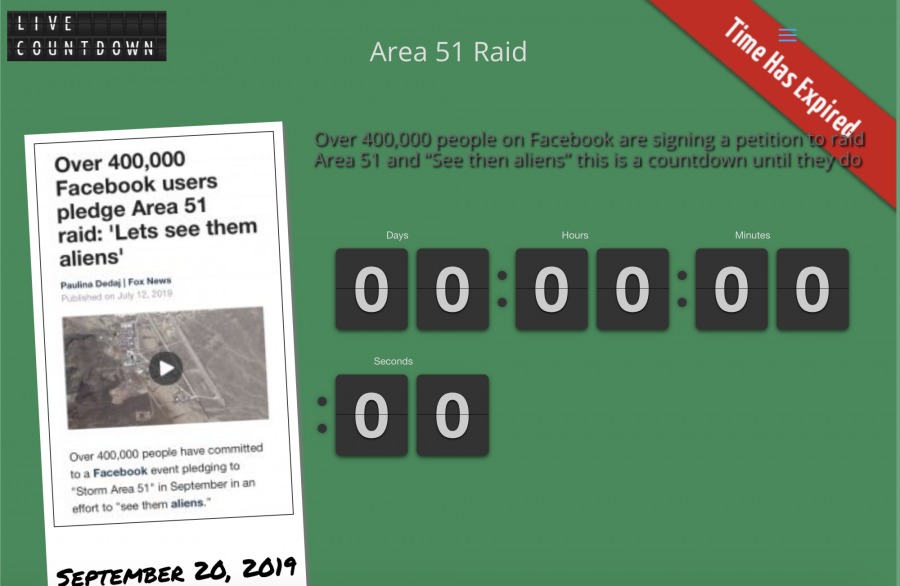
A live countdown on a site counted down until the Area 51 raid.
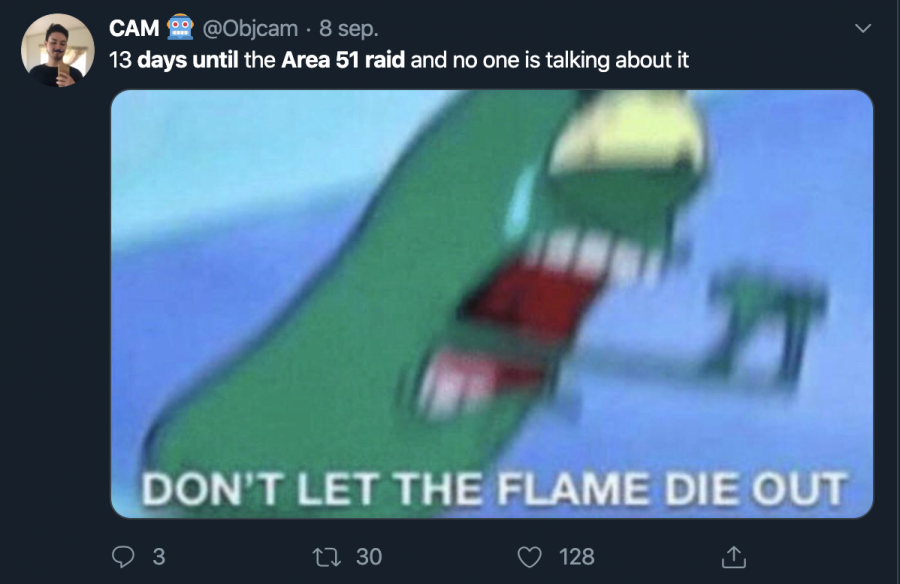
Tweeters count down the days until the raid on Twitter to raise awareness.
As for language, English with loads of slang elements is the main language used by the raiders. The kind of language they use is characteristic of their young age range and particular strands of youth culture. So, to be part of the group you have to be interested in memes, gaming, Area 51 conspiracies and actively use YouTube, Reddit or 4Chan. The ability to Naruto run is also crucial, of course. Since these things are pretty common among young people, this makes it very difficult for raiders to stand out. This means that Area 51 raiders are not really a deviant group in that sense. you couldn’t look at someone and their behavior and immediately say 'that’s an Area 51 raider'. What you can say about these raiders is that they have shared interests and behaviors, but the group is ultimately made out of different bigger groups, such as gamers, memers, and others.
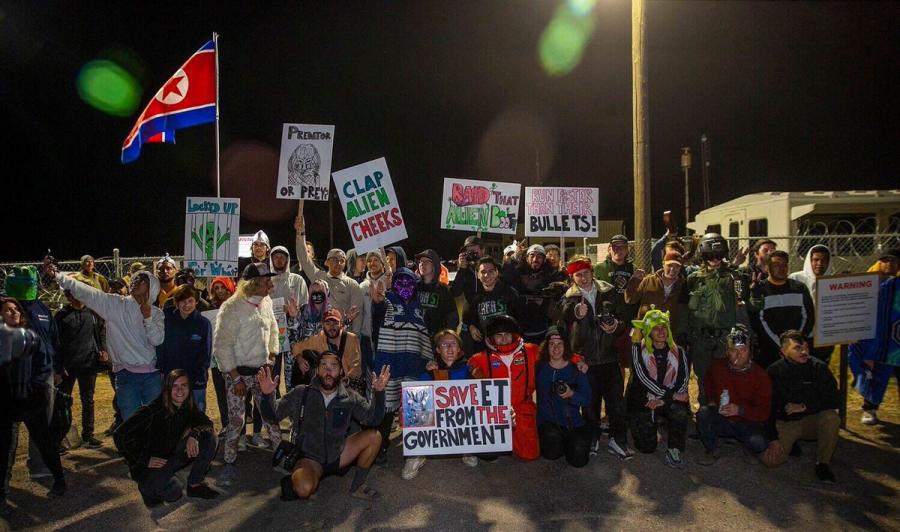
Group picture of Area 51 raiders.
Are Area 51 raiders a micro-population?
The main question we posed in this article was whether Area 51 raiders should be seen as a social group, as the material expression of temporary and emerging micro-hegemonies. The term micro-hegemony refers to "the dominance of certain ideas, images, discourses and ideologies in specific domains" in relation to smaller, more detailed groups that consist of people that present basically the same traits, but who also belong to other groups in different contexts.
Area 51 raiders do indeed have certain emblematic features, but these features are also shared by many other groups of people.
Now, according to Jan Blommaert and Piia Varis, there is a four-point framework to describe and define a micro-hegemony. But do Area 51 raiders fit into it?
The first point says that there are sets of features that are seen (or can be seen) as emblematic for that specific social group. In our case, Area 51 raiders do indeed have certain emblematic features, but these features are also shared by many other groups of people. Being a memer and/or a gamer with an interest in alien conspiracy theories does not immediately make you a raider. Talking about the event or actually showing up does, however, but there are no other essential features. Others often can’t immediately identify a raider, so this first point of the framework doesn't apply to Area 51 raiders.

Meme made about the differences between 'memers' and 'gamers' within the Area 51 raid.
The next point states that there are certain rules or expectations for people that are part of the group, which can be understood as features that reflect, bestow, and emphasize authenticity. This is indeed the case for Area 51 raiders. Raiders are expected to have knowledge over the Area 51 conspiracies, understand the memes, and of course know where it all started: with a Facebook event. If you fulfill these criteria and the ones that I described earlier, you will fit in the picture of an authentic Area 51 raider.
The third point says that there are certain layers in the social group itself, where you can prove yourself to be 'more of' an Area 51 raider, or a 'better' raider. You can, for instance, go up from novice to expert. It is very difficult to argue that this point applies to Area 51 raiders since the whole raid situation didn’t last long enough for it to really develop in a structured social group. You could, of course, argue that the people who actually went would be the Area 51 ‘legends’, but since that only happened once, one cannot advance as a raider anymore. The creator of the Facebook event would also be seen as a leader in a way, but that is not what’s happening apparently either. With the demise of the group, the issue of mobility within it becomes hard to discuss.

Matty Roberts, creator of the Facebook event, could be seen as the leader of the social group.
The last point of Varis and Blommaert's framework describes the term 'enoughness' in the sense of being considered enough to be a part of the social group or micro-population. You need to find a balance between being not enough of an Area 51 raider and too much of an Area 51 raider in order to be considered one. You can become enough of a raider by having the expected features, knowledge or behavior. This is basically the same as I just described, but of course, you can’t take it too far. When you take the alien obsession too far, people will just see you as an alien fanatic instead of a raider. The same goes with the gaming and memes, you should moderate it all to be just enough of an Area 51 raider.
Micro-populations or social groups are groups that can be put together based on style, the places where you can find them and the places where you can’t find them. Area 51 raiders do have some aspects that might make them a social group, but there are many facts that prevent them from being describable as one. The group became too big too fast and died too early to develop into a proper social group. They have little to no emblematic features, they are deviant (but kind of dying out), and you can’t really grow within the group anymore since it lasted such a short time. Area 51 raiders do have some characteristics of a social group, but ultimately shouldn’t be considered one, since they are made up of people ascribing to bigger micro-hegemonies that you can still actively participate in (gamers, memers, conspiracy theorists, etc.).
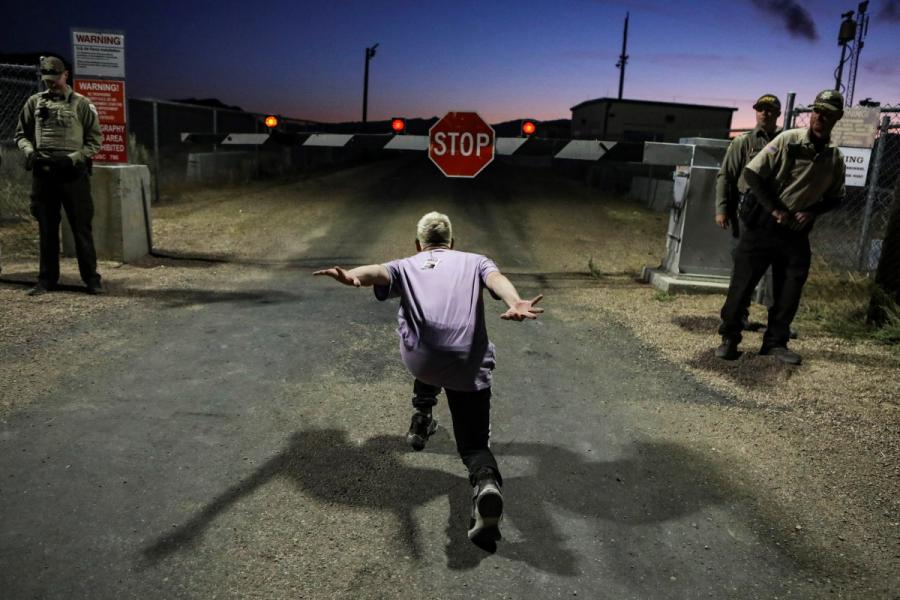
References
Baynes, C. (2019, 2"1 september). Storm Area 51: Hundreds of people gather at US military base to “see them aliens”. The Independent.
BBC News. (2019, 22 september). Area 51: US military sorry over bomber raid tweet.
Betz, B. (2019, 18 juli). Creator of ’Storm Area 51’ comes forward after satirical Facebook page takes off. Fox News.
Fortin, J. (2019, 16 juli). Storm Area 51? It’s a Joke, but the Air Force Is Concerned. The New York Times.
Hoffman, A. (2019, 23 september). People Weren’t Kidding About That Area 51 Raid and the Videos Were Fun Enough to Make Everyone a Believer. Time.
Maly, I. & Varis, P. (2015). The 21st-century hipster: On micro-populations in times of superdiversity. European Journal of Cultural Studies, 1-17.